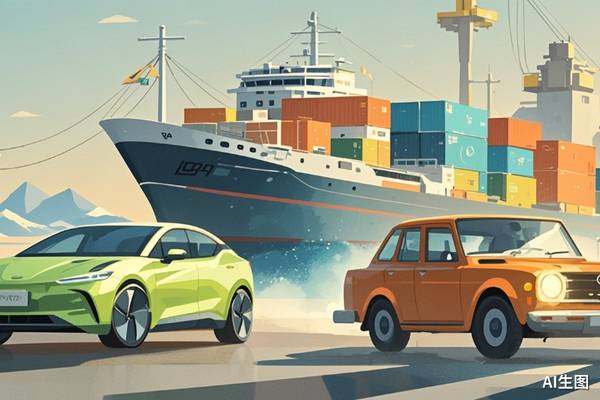On November 11th, the China Association of Automobile Manufacturers (hereinafter referred to as “CAAM”) released the latest statistical data. In October 2025, the Chinese automobile market continued its high – growth trend. The monthly production and sales reached 3.359 million and 3.322 million vehicles respectively, with year – on – year increases of 12.1% and 8.8% respectively, both setting new records for the same period in history. Among them, the sales volume of new energy vehicles accounted for over 50% for the first time, reaching 1.715 million vehicles. This strong performance has set the tone for the automotive market to exceed expectations in terms of growth throughout the year.
Looking at the first ten months, the structural changes in the automotive industry are particularly significant. The cumulative sales volume of new energy vehicles has approached 50%, rivaling that of traditional fuel vehicles. Meanwhile, the monthly automobile export volume has remained above 600,000 vehicles for three consecutive months. The cumulative total in the first ten months reached 5.62 million vehicles, approaching the full – year level of 2024.
Chen Shihua, the deputy secretary – general of CAAM, said that driven by the “two new” policies (trade – in of old cars for new ones and scrapping and renewal), it is expected that the total production and sales volume of automobiles in 2025 will exceed the initial forecast of 34 million vehicles, setting a new historical high. However, beneath the surface of rapid progress, the industry is at a critical policy window period.
In response to the adjustment of the purchase tax incentive policy for new energy vehicles in 2026, Chen Shihua called on relevant departments to optimize the policies and clarify the implementation rules to stabilize market expectations and help the industry operate smoothly.
According to CAAM statistics, in October 2025, China’s automobile production and sales reached 3.359 million and 3.322 million vehicles respectively, with a month – on – month increase of over 2.5% and a year – on – year increase of 12.1% and 8.8% respectively. In the first ten months, China’s cumulative automobile production and sales reached 27.692 million and 27.687 million vehicles respectively, with year – on – year increases of 13.2% and 12.4% respectively.
Chen Shihua said that despite the complex and severe external environment, the stable operation of the macro – economy has promoted the positive development of the automobile industry. Automobile manufacturers seized the policy transition window period at the end of the year in October, maintaining a relatively fast production rhythm, which led to the monthly production and sales reaching new highs for the same period. He expects that driven by the “two new” policies, the total production and sales volume of automobiles in 2025 will exceed the initial forecast of 34 million vehicles, setting a new historical high.
Focusing on the Chinese automobile consumer market, in the first ten months, the cumulative automobile sales reached 22.072 million vehicles, with a year – on – year increase of nearly 12%. Among them, the cumulative sales volume of new energy vehicles was 10.929 million vehicles, with a year – on – year increase of 26%, and the market share reached 49.5%; the sales of traditional fuel vehicles stopped declining and rebounded, with a cumulative sales volume of 11.143 million vehicles, a year – on – year increase of 0.6%.
Chen Shihua said that although the growth rate of traditional fuel vehicles is not high, it has reversed the significant decline in 2025. At the same time, he also pointed out: “According to the association’s monitoring, we have noticed that the terminal price of the domestic traditional fuel passenger vehicle market has still dropped significantly.”
In terms of exports, in October, China exported 666,000 vehicles, a year – on – year increase of 23%, remaining above 600,000 vehicles for the third consecutive month. Looking back at the first ten months, China’s cumulative automobile exports reached 5.62 million vehicles, approaching the full – year level of 2024. Among them, new energy vehicles have become the core growth pole of exports, with cumulative exports of 2.014 million vehicles, a year – on – year increase of over 90%; the exports of traditional fuel vehicles decreased by 5% year – on – year.
In terms of enterprise rankings, Chery ranked first with an export volume of 1.063 million vehicles; BYD had the most significant growth, exporting 789,000 vehicles, a year – on – year increase of 1.4 times, and rising to second place.
Behind the impressive data, the policy cycle transition has become the focus of the industry. Chen Shihua emphasized that the Fourth Plenary Session of the 20th Central Committee of the Communist Party of China and the “Proposal of the Central Committee of the Communist Party of China for Formulating the 15th Five – Year Plan for National Economic and Social Development” clearly put forward the goal of “vigorously boosting consumption” and made specific arrangements, sending out positive signals. 2026 is the first year of the “15th Five – Year Plan”, and promoting consumption remains one of the key tasks.
However, 2026 will also be a year of in – depth adjustment of China’s automobile industry policies. According to a joint announcement by relevant ministries such as the Ministry of Industry and Information Technology and the Ministry of Finance, from 2026 to 2027, the purchase tax for new energy vehicles will be halved, and the tax reduction for each new energy passenger vehicle will not exceed 15,000 yuan. At the same time, the pure – electric range threshold for plug – in hybrid (including extended – range) passenger vehicles will be significantly increased from 43 kilometers to 100 kilometers (WLTC conditions).
In response, Chen Shihua said that since the second half of 2024, the trade – in policy for old cars has had a significant impact on the market, and it is not yet clear whether the policy will continue. Considering the implementation of the above new policies in 2026, to reduce market fluctuations, he suggested that relevant departments continue to optimize and implement relevant policies in 2026 to ensure a smooth transition for the industry. Previously, he publicly proposed that the purchase tax reduction policy should be phased out in a stepped manner, with a 3% reduction in 2026 and a 7% reduction in 2027, and that comprehensive rectification of the industry’s internal competition should be strengthened, along with enhanced policy guidance and supervision.
Overall, in the first ten months, the Chinese automobile market continued to improve. Among them, the sales volume of Chinese – brand passenger vehicles reached 16.799 million vehicles, a year – on – year increase of 21%, and the sales share was close to 70%. In the commercial vehicle market, the sales volume of new energy commercial vehicles reached a new historical high, with a cumulative total of 649,000 vehicles, a year – on – year increase of over 60%.
Against this background, the industry still needs to recognize that the current automobile market still faces multiple challenges such as slow growth in domestic demand, inventory pressure that requires caution, continuous pressure on industry profitability, the risk of price wars, and the impact of geopolitics on the stability of the industrial chain. The economic operation of the automobile industry still faces significant pressure, Chen Shihua pointed out.
Note: All the above pictures are from CAAM.
This article is from the WeChat official account “Financial Automobile”, written by Song Liwei and Zhao Cheng, and is published by 36Kr with authorization.
该文观点仅代表作者本人,36氪平台仅提供信息存储空间服务。
36kr Europe (eu.36kr.com) delivers global business and markets news, data, analysis, and video to the world, dedicated to building value and providing business service for companies’ global expansion.
© 2024 36kr.com. All rights reserved.


















